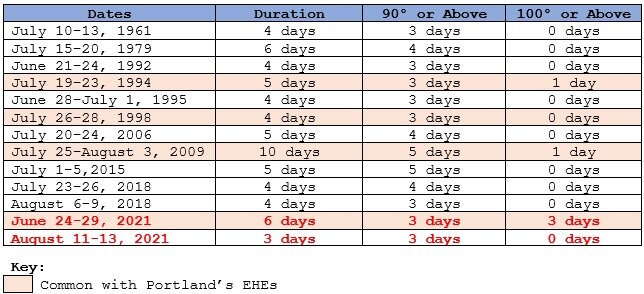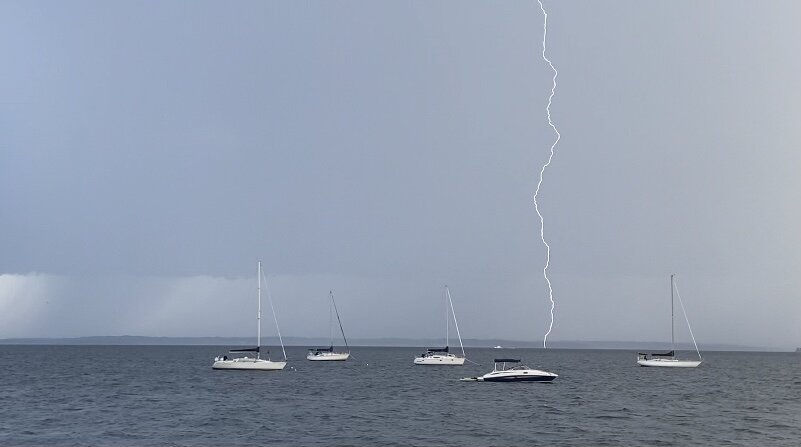-
Posts
23,098 -
Joined
Content Type
Profiles
Blogs
Forums
American Weather
Media Demo
Store
Gallery
Everything posted by donsutherland1
-
There's a lot of uncertainty--a real model battle is underway. The ECMWF, RGEM, and GGEM favor a lot of rainfall. The GFS and NAM don't. Right now, something between 0.50"-1.00" appears more likely than rainfall approaching 3" or the much drier GFS/NAM idea. It's tough to place the predecessor rainfall event even this close to the onset. I think we'll know a lot more by sometime between 12z and 0z.
-
Morning thoughts… It will be mostly cloudy and a bit cooler today. Showers are possible. Temperatures will likely reach the upper 70s and lower 80s in most of the region. Likely high temperatures around the region include: New York City (Central Park): 79° Newark: 83° Philadelphia: 83° Normals: New York City: 30-Year: 83.4°; 15-Year: 83.3° Newark: 30-Year: 84.7°; 15-Year: 85.0° Philadelphia: 30-Year: 85.9°; 15-Year: 85.7° Cooler conditions will persist through much of the week.
-
Temperatures generally ranged from the lower to middle 80s across the region today. Much of the week will be a few degrees cooler with highs mainly topping out in the upper 70s and lower 80s. In addition, parts of the region could moderate to heavy rainfall on Wednesday into Thursday. The heaviest rain is likely to fall south and west of New York City. Out West, Boise will very likely wind up with its warmest summer on record. Other cities in the running for their warmest summer on record include Portland, Reno, and Salt Lake City. The ENSO Region 1+2 anomaly was +0.1°C and the Region 3.4 anomaly was -0.4°C for the week centered around August 11. For the past six weeks, the ENSO Region 1+2 anomaly has averaged +0.45°C and the ENSO Region 3.4 anomaly has averaged -0.28°C. Neutral ENSO conditions will likely prevail into mid-September. The SOI was +3.94 today. The preliminary Arctic Oscillation (AO) figure was +1.310 today. On August 14 the MJO was in Phase 2 at an amplitude of 2.231 (RMM). The August 13-adjusted amplitude was 2.305 (RMM). Based on sensitivity analysis applied to the latest guidance, there is an implied 56% probability that New York City will have a warmer than normal August (1991-2020 normal). August will likely finish with a mean temperature near 76.4° (0.4° above normal).
-
Morning thoughts… It will be partly sunny and a bit cooler today. Temperatures will likely reach the upper 70s and lower 80s in most of the region. Likely high temperatures around the region include: New York City (Central Park): 81° Newark: 84° Philadelphia: 84° Normals: New York City: 30-Year: 83.5°; 15-Year: 83.4° Newark: 30-Year: 84.9°; 15-Year: 85.1° Philadelphia: 30-Year: 86.0°; 15-Year: 85.8° Cooler conditions will persist through much of the week.
-
In the wake of yesterday's cold front, today saw temperatures hold in the lower and middle 80s across the region. Much of the upcoming week will be a few degrees cooler with highs mainly topping out in the upper 70s and lower 80s. In addition, parts of the region could receive some rainfall on Thursday from Fred. The heaviest rain is likely to fall south and west of New York City. The ENSO Region 1+2 anomaly was +0.7°C and the Region 3.4 anomaly was -0.3°C for the week centered around August 4. For the past six weeks, the ENSO Region 1+2 anomaly has averaged +0.48°C and the ENSO Region 3.4 anomaly has averaged -0.23°C. Neutral ENSO conditions will likely prevail into mid-September. The SOI was +0.49 today. The preliminary Arctic Oscillation (AO) figure was +1.433 today. On August 13 the MJO was in Phase 1 at an amplitude of 2.305 (RMM). The August 12-adjusted amplitude was 2.419 (RMM). Based on sensitivity analysis applied to the latest guidance, there is an implied 56% probability that New York City will have a warmer than normal August (1991-2020 normal). August will likely finish with a mean temperature near 76.3° (0.3° above normal).
-

Historic Pacific Northwest Heatwave of 2021
donsutherland1 replied to donsutherland1's topic in Climate Change
- 323 replies
-
- 1
-

-
Morning thoughts… It will be partly sunny and cooler today. Temperatures will likely reach the lower and middle 80s in most of the region. Likely high temperatures around the region include: New York City (Central Park): 82° Newark: 87° Philadelphia: 85° Normals: New York City: 30-Year: 83.6°; 15-Year: 83.6° Newark: 30-Year: 85.0°; 15-Year: 85.3° Philadelphia: 30-Year: 86.1°; 15-Year: 86.0° Cooler conditions will persist through much of the week.
-
Today featured temperatures in the upper 80s and lower 90s across the region. Cooler temperatures are likely starting tomorrow. 90° Days for Select Cities (through August 14): Albany: 4 (2020: 13 days; 5-Year Average: 13.6 days) Allentown: 21 (2020: 24 days; 5-Year Average: 27.6 days) Baltimore: 42 (2020: 46 days; 5-Year Average: 44.6 days) Boston: 20 (2020: 14 days; 5-Year Average: 17.2 days) Bridgeport: 10 (2020: 11 days; 5-Year Average: 13.4 days) Burlington: 9 (2020: 20 days; 5-Year Average: 13.0 days) Harrisburg: 28 (2020: 35 days; 5-Year Average: 30.6 days) Hartford: 21 (2020: 39 days; 5-Year Average: 29.0 days) Islip: 6 (2020: 8 days; 5-Year Average: 9.4 days) New York City-JFK: 8 (2020: 12 days; 5-Year Average: 10.2 days) New York City-LGA: 21 (2020: 34 days; 5-Year Average: 29.4 days) New York City-NYC: 14 (2020: 20 days; 5-Year Average: 18.2 days) Newark: 32 (2020: 32 days; 5-Year Average: 31.2 days) Philadelphia: 29 (2020: 36 days; 5-Year Average: 34.6 days) Scranton: 16 (2020: 25 days; 5-Year Average: 16.4 days) Washington, DC: 38 (2020: 46 days; 5-Year Average: 50.8 days) New York City-Newark Average: 19 (2020: 22 days) ...Expected: 21 (based on regression equation tied to JFK-LGA-EWR data) A cold front will move across the region tomorrow. It could trigger showers and thunderstorms. Sunday will turn cooler. At least the first half of next week will likely see near to somewhat below normal readings. The ENSO Region 1+2 anomaly was +0.7°C and the Region 3.4 anomaly was -0.3°C for the week centered around August 4. For the past six weeks, the ENSO Region 1+2 anomaly has averaged +0.48°C and the ENSO Region 3.4 anomaly has averaged -0.23°C. Neutral ENSO conditions will likely prevail into mid-September. The SOI was -4.67 today. The preliminary Arctic Oscillation (AO) figure was +0.628 today. On August 12 the MJO was in Phase 2 at an amplitude of 2.423 (RMM). The August 11-adjusted amplitude was 2.403 (RMM). The August 12 preliminary amplitude would surpass the August record amplitude of 2.329 during Phase 2, which was set on August 16, 2009. Extremely strong passage of the MJO through Phase 2 at this time of year has often been followed by additional bouts of heat in the Pacific Northwest into at least mid-autumn. Based on sensitivity analysis applied to the latest guidance, there is an implied 56% probability that New York City will have a warmer than normal August (1991-2020 normal). August will likely finish with a mean temperature near 76.3° (0.3° above normal).
-
Under partly sunny skies, the temperature rose into the upper 80s at the New York Botanical Garden this afternoon.
-
Morning thoughts… It will be partly sunny and very warm into the afternoon. Afterward, showers and thunderstorms are likely as a cold front crosses the region. Temperatures will likely reach the upper 80s and lower 90s. Likely high temperatures around the region include: New York City (Central Park): 88° Newark: 93° Philadelphia: 91° Normals: New York City: 30-Year: 83.7°; 15-Year: 83.8° Newark: 30-Year: 85.0°; 15-Year: 85.5° Philadelphia: 30-Year: 86.2°; 15-Year: 86.1° It will be come cooler tomorrow into next week.
-
Temperatures surged into the 90s across most of the region today. 90° Days for Select Cities (through August 13): Albany: 4 (2020: 13 days; 5-Year Average: 13.6 days) Allentown: 21 (2020: 24 days; 5-Year Average: 27.6 days) Baltimore: 40 (2020: 46 days; 5-Year Average: 44.6 days) Boston: 19 (2020: 14 days; 5-Year Average: 17.2 days) Bridgeport: 10 (2020: 11 days; 5-Year Average: 13.4 days) Burlington: 9 (2020: 20 days; 5-Year Average: 13.0 days) Harrisburg: 28 (2020: 35 days; 5-Year Average: 30.6 days) Hartford: 20 (2020: 39 days; 5-Year Average: 29.0 days) Islip: 5 (2020: 8 days; 5-Year Average: 9.4 days) New York City-JFK: 7 (2020: 12 days; 5-Year Average: 10.2 days) New York City-LGA: 20 (2020: 34 days; 5-Year Average: 29.4 days) New York City-NYC: 14 (2020: 20 days; 5-Year Average: 18.2 days) Newark: 31 (2020: 32 days; 5-Year Average: 31.2 days) Philadelphia: 28 (2020: 36 days; 5-Year Average: 34.6 days) Scranton: 16 (2020: 25 days; 5-Year Average: 16.4 days) Washington, DC: 37 (2020: 46 days; 5-Year Average: 50.8 days) New York City-Newark Average: 18 (2020: 22 days) ...Expected: 20 (based on regression equation tied to JFK-LGA-EWR data) A cold front will move across the region tomorrow. It could trigger showers and thunderstorms. Sunday will turn cooler. At least the first half of next week will likely see near to somewhat below normal readings. The ENSO Region 1+2 anomaly was +0.7°C and the Region 3.4 anomaly was -0.3°C for the week centered around August 4. For the past six weeks, the ENSO Region 1+2 anomaly has averaged +0.48°C and the ENSO Region 3.4 anomaly has averaged -0.23°C. Neutral ENSO conditions will likely prevail into mid-September. The SOI was +3.34 today. The preliminary Arctic Oscillation (AO) figure was -0.008 today. On August 11 the MJO was in Phase 2 at an amplitude of 2.408 (RMM). The August 10-adjusted amplitude was 1.962 (RMM). Based on sensitivity analysis applied to the latest guidance, there is an implied 54% probability that New York City will have a warmer than normal August (1991-2020 normal). August will likely finish with a mean temperature near 76.2° (0.2° above normal).
-

Historic Pacific Northwest Heatwave of 2021
donsutherland1 replied to donsutherland1's topic in Climate Change
Select high temperatures for August 13, 2021: Bellingham, WA: 100° (old record: 85°, 1956 and 1977) ***New All-Time Record*** Boise: 100° Dallesport, WA: 108° (old record: 107°, 1977) Eugene, OR: 104° (old record: 102°, 1977) Medford, OR: 103° Olympia: 96° (tied record set in 1977) Pendleton, OR: 102° Portland: 103° ***Record-tying 5th 100° day this year*** Salem, OR: 103° Seattle: 95° Portland's minimum temperature of 70° set a new August record for highest minimum temperature.- 323 replies
-
- 2
-

-
Morning thoughts… It will become partly sunny and hot. An afternoon or evening thunderstorm is possible. Temperatures will likely reach the lower and middle 90s. Some locations will reach the upper 90s. Likely high temperatures around the region include: New York City (Central Park): 94° Newark: 99° Philadelphia: 97° Normals: New York City: 30-Year: 83.8°; 15-Year: 83.9° Newark: 30-Year: 85.2°; 15-Year: 85.6° Philadelphia: 30-Year: 86.3°; 15-Year: 86.3° Very warm weather will continue tomorrow. Showers and thunderstorms are likely as a front moves across the region. Out West, Portland will likely experience its record 6th 100° day of the year.
-

Historic Pacific Northwest Heatwave of 2021
donsutherland1 replied to donsutherland1's topic in Climate Change
773 SXUS76 KSEW 130134 RERSEW RECORD EVENT REPORT NATIONAL WEATHER SERVICE SEATTLE 634 PM PDT THU AUG 12 2021 ...ALL TIME HIGH TEMPERATURE SET TODAY AT BELLINGHAM WA... ...MULTIPLE DAILY RECORD HIGH TEMPERATURES SET TODAY ACROSS WESTERN WASHINGTON... BELLINGHAM WA RECORDED A TEMPERATURE OF 100 DEGREES TODAY, REACHING THIS MARK FOR THE FIRST TIME ON RECORD. THE PREVIOUS RECORD MAXIMUM TEMPERATURE WAS 99 DEGREES SET EARLIER THIS YEAR ON JUNE 28. RECORDS DATE BACK TO 1949. THIS IS, OF COURSE, ALSO THE RECORD WARMEST TEMPERATURE RECORDED AT BELLINGHAM IN THE MONTH OF AUGUST. THE PREVIOUS MARK WAS 94 DEGREES, SET ON BOTH AUGUST 8 1978 AND AUGUST 9 1960. IN ADDITION TO BELLINGHAM, SEVERAL OTHER LOCATIONS SET OR TIED RECORD MAXIMUM TEMPERATURES FOR THE DATE, AUGUST 12. LOCATION HIGH TEMPERATURE PREVIOUS RECORD / DATE --------------------------------------------------------- BELLINGHAM 100 85 / 1956 OLYMPIA 96 (T) 96 / 1977 NWS SEATTLE 93 (T) 93 / 1977 HOQUIAM 88 84 / 1977 $$ CULLEN- 323 replies
-
- 1
-

-

Historic Pacific Northwest Heatwave of 2021
donsutherland1 replied to donsutherland1's topic in Climate Change
On June 28, 2021, the temperature at Bellingham, WA reached 99°, which broke the all-time record of 96° that had been set on July 29, 2009. Today, the temperature rose to 100° at Bellingham, which eclipsed the all-time record set during the historic June heat wave.- 323 replies
-
- 2
-

-
There was a brief period of high winds in Larchmont. A limb and some large branches were down following the storm, which really blew up over the Long Island Sound.
-
I will try to play around with the camera next time there’s a daytime thunderstorm.
-
I didn't have my camera with me, as I was coming back from work. I shot it with my iPhone. If I recall correctly, one has to use the "Bulb" setting for shutter speed and ISO of either 100 or 200. Then the shutter stays open until there have been one or more lightning flashes. A tripod is needed and a remote is useful.
-
Temperatures surged into the 90s across most of the region today. High temperatures included: Allentown: 94° Baltimore: 98° Boston: 96° Bridgeport: 93° Concord: 93° Harrisburg: 96° Hartford: 95° Islip: 90° (tied record set in 2016) New York City-JFK: 88° New York City-LGA: 98° (tied record set in 2016) New York City-NYC: 93° Newark: 98° (tied record set in 1944) Philadelphia: 96° Poughkeepsie: 95° Providence: 94° Scranton: 93° Washington, DC: 96° 90° Days for Select Cities (through August 12): Albany: 4 (2020: 13 days; 5-Year Average: 13.6 days) Allentown: 20 (2020: 24 days; 5-Year Average: 27.6 days) Baltimore: 39 (2020: 46 days; 5-Year Average: 44.6 days) Boston: 18 (2020: 14 days; 5-Year Average: 17.2 days) Bridgeport: 9 (2020: 11 days; 5-Year Average: 13.4 days) Burlington: 8 (2020: 20 days; 5-Year Average: 13.0 days) Harrisburg: 27 (2020: 35 days; 5-Year Average: 30.6 days) Hartford: 19 (2020: 39 days; 5-Year Average: 29.0 days) Islip: 4 (2020: 8 days; 5-Year Average: 9.4 days) New York City-JFK: 6 (2020: 12 days; 5-Year Average: 10.2 days) New York City-LGA: 19 (2020: 34 days; 5-Year Average: 29.4 days) New York City-NYC: 13 (2020: 20 days; 5-Year Average: 18.2 days) Newark: 31 (2020: 31 days; 5-Year Average: 31.2 days) Philadelphia: 27 (2020: 36 days; 5-Year Average: 34.6 days) Scranton: 15 (2020: 25 days; 5-Year Average: 16.4 days) Washington, DC: 36 (2020: 46 days; 5-Year Average: 50.8 days) New York City-Newark Average: 17 (2020: 22 days) ...Expected: 19 (based on regression equation tied to JFK-LGA-EWR data) Searing heat again baked the Pacific Northwest. High temperatures included: Dallesport, WA: 108° (old record: 107°, 1977) Eugene, OR: 103° Medford, OR: 103° Pendleton, OR: 102° Portland: 102° ***Record-tying 5th 100° day this year*** Salem: 102° Seattle: 93° As a result of the ongoing bout of extreme heat, Portland will likely experience its second extreme heat event of the year, making 2021 the first year on record with two such events. Portland could also experience 2 or more 100° high temperatures, allowing 2021 to tie or break the all-time record for most such days. There is an increased possibility that Seattle could also experience its second extreme heat event of the year. In some of the long-range guidance that heat could later be followed by another round of heat in the Northern Plains a week or so later. If so, one will see a similar sequence of events as occurred from late June to mid-July. The ENSO Region 1+2 anomaly was +0.7°C and the Region 3.4 anomaly was -0.3°C for the week centered around August 4. For the past six weeks, the ENSO Region 1+2 anomaly has averaged +0.48°C and the ENSO Region 3.4 anomaly has averaged -0.23°C. Neutral ENSO conditions will likely prevail into mid-September. The SOI was +6.13 today. The preliminary Arctic Oscillation (AO) figure was -0.126 today. On August 10 the MJO was in Phase 2 at an amplitude of 1.894 (RMM). The August 9-adjusted amplitude was 1.435 (RMM). Based on sensitivity analysis applied to the latest guidance, there is an implied 54% probability that New York City will have a warmer than normal August (1991-2020 normal). August will likely finish with a mean temperature near 76.2° (0.2° above normal).
-
-
I agree. I could see LGA reaching 95-96, but Central Park topping out at 92-93.
-

Historic Pacific Northwest Heatwave of 2021
donsutherland1 replied to donsutherland1's topic in Climate Change
It has happened just twice: July 23, 1991: NYC 99; SEA 99 August 4, 1993: NYC 96; SEA 95- 323 replies
-
- 1
-

-
Morning thoughts… Early showers will depart. It will become mostly sunny and hot. Temperatures will likely reach the lower and middle 90s. Some locations will reach the upper 90s. Likely high temperatures around the region include: New York City (Central Park): 93° Newark: 99° Philadelphia: 97° Normals: New York City: 30-Year: 83.9°; 15-Year: 84.1° Newark: 30-Year: 85.3°; 15-Year: 85.8° Philadelphia: 30-Year: 86.4°; 15-Year: 86.4° Hot weather will continue tomorrow.
-

Severe June 2021 Heatwave in Phoenix and Tucson
donsutherland1 replied to donsutherland1's topic in Climate Change
July was Tucson’s wettest month on record.- 33 replies
-
- 1
-

-
- heatwave
- extreme heat event
- (and 5 more)
-

Historic Pacific Northwest Heatwave of 2021
donsutherland1 replied to donsutherland1's topic in Climate Change
Select high temperatures for August 11, 2021: Dallesport, WA: 110° (old record: 109°, 1981) Eugene, OR: 102° Medford, OR: 104° Pendleton, OR: 101° Portland: 102° (tied record set in 1977) Richland, WA: 107° (tied record set in 1958) Salem, OR: 103° Seattle: 91°- 323 replies
-
- 1
-









